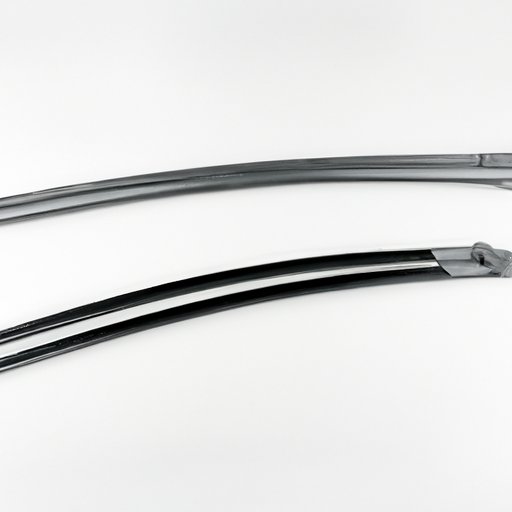
Introduction
Changing your wiper blades is an essential part of car maintenance that is often overlooked. However, failing to replace worn wiper blades can reduce your visibility on the road and be dangerous for you and other drivers. This article is a comprehensive guide on how to change wiper blades. Whether you’re a first-time car owner or just looking for some tips to make the process easier, this article has got you covered!
Step-by-step guide
To change wiper blades, you will need a few tools, including:
- New wiper blades
- Small flat-head screwdriver
- Towel or rag
Here is an overview of the steps involved in changing wiper blades:
- Locate the release mechanism
- Unhook the old wiper blade
- Remove old wiper blade
- Attach new wiper blade
- Test new wiper blade
To understand these steps in more detail, follow the instructions below:
Step 1: Locate the release mechanism
The release mechanism is usually located on the underside of the wiper arm. Use a small flat-head screwdriver to remove the release mechanism cover.
Step 2: Unhook the old wiper blade
With the release mechanism exposed, locate the tab that holds the wiper blade in place. Usually, this tab is located at the center of the wiper blade. Push the tab and gently pull the wiper blade off the wiper arm.
Step 3: Remove old wiper blade
Once you have unhooked the old wiper, gently slide it out of the wiper arm. Make sure to keep it away from the windshield to avoid damaging it.
Step 4: Attach new wiper blade
Take the new wiper blade and attach it to the wiper arm, lining up the hook with the slot in the wiper arm. Once the hook is in place, gently push the wiper blade until you hear a click, indicating that it is locked in place. Replace the release mechanism cover.
Step 5: Test new wiper blade
Turn on your wipers and test your new wiper blade. Make sure that it clears the windshield completely and without leaving streaks. If it doesn’t, adjust it by repeating steps 3 and 4.
Product review and recommendation
When it comes to wiper blades, there are a variety of options available on the market. Some of the best wiper blades currently available include:
- Bosch Icon Wiper Blades
- Rain-X Latitude Wiper Blades
- Valeo 900 Series Wiper Blades
- ANCO 31 Series Wiper Blades
- Trico Flex Wiper Blades
Each of these products has its advantages depending on your driving needs and budget. To determine which wiper blade is right for you, consider factors such as durability, noise level, and effectiveness in different weather conditions. For step-by-step instructions on how to install each of these wiper blades, consult the manufacturer’s website or your vehicle’s manual. For convenience, you can also purchase these products at auto supply stores or online shops.
Maintenance tips
Proper maintenance is crucial to extending the lifespan of wiper blades and ensuring your safety on the road. Here are a few practical tips to help you maintain your wiper blades:
- Clean your windshield regularly to prevent debris buildup.
- Do not use your wiper blades to scrape ice off your windshield. Use an ice scraper instead.
- Keep your wiper blades away from intense heat and sunlight.
- Periodically, wipe down your wiper blades with vinegar or rubbing alcohol to remove any buildup of grime or dirt.
Common mistakes to avoid
Although changing wiper blades is a relatively straightforward process, mistakes can happen. Here are some of the most common mistakes to avoid:
- Installing the wrong size wiper blade
- Forgetting to remove the protective cover on the wiper blade
- Applying too much pressure while unhooking or installing the wiper blade, which can lead to damage
- Not testing the new wiper blade before driving
By avoiding these common mistakes, you can prevent damage to your car and ensure your safety on the road.
DIY vs professional installation
While changing your own wiper blades is a viable option for many people, there are instances where professional installation may be necessary. The advantages of professional installation include:
- Expertise and experience in handling different types of wiper blades
- Access to specialized tools and equipment
- Less risk of damaging your car
However, DIY installation also has its advantages, including:
- Saving money on installation fees
- Flexibility to install your own wiper blades at your own convenience
- Hands-on experience and knowledge of car maintenance
Ultimately, the choice of whether to install wiper blades yourself or seek professional help depends on your skills, tools, and comfort level. For step-by-step instructions on how to change wiper blades, consult your vehicle’s manual or visit a reputable website.
Environmental impact
When changing your wiper blades, it’s essential to consider the environmental impact of disposing of old wiper blades. Here are a few eco-friendly options:
- Recycling: Many auto and repair shops accept used wiper blades for recycling. Check with your local recycling center for more information.
- Reusing: Consider reusing your old wiper blades for DIY projects or as a makeshift tool in your garage or workshop.
- Reducing waste: Proper maintenance and regular replacement of wiper blades can reduce the need for disposal of old wiper blades.
Conclusion
Changing wiper blades may seem like a small task, but it can have a big impact on your safety and visibility on the road. In this article, we’ve provided a comprehensive guide on how to change wiper blades, product reviews and recommendations, maintenance tips, common mistakes to avoid, DIY vs professional installation, and eco-friendly options for recycling or reusing old wiper blades. Whether you’re a seasoned DIY enthusiast or new to car maintenance, the tips and advice in this article will help you stay safe on the road and extend the lifespan of your wiper blades.





